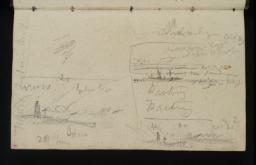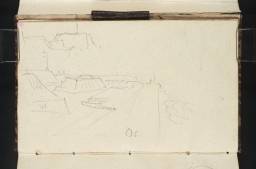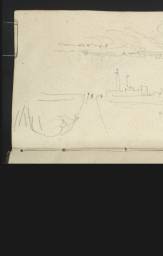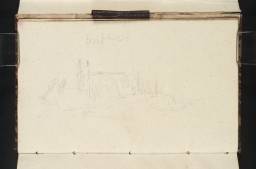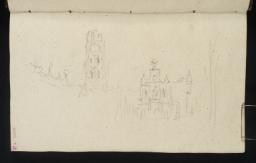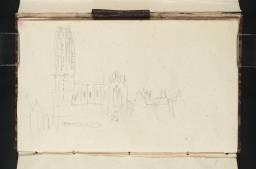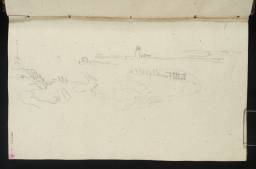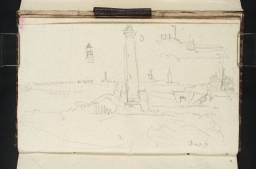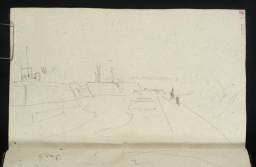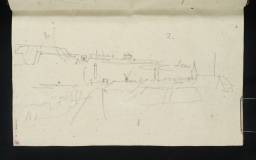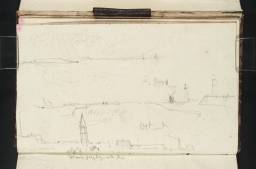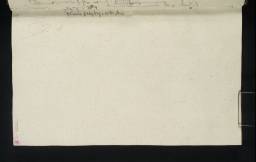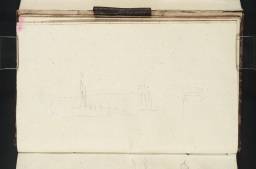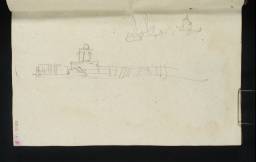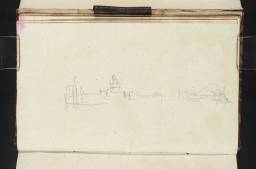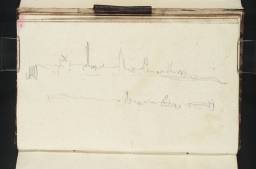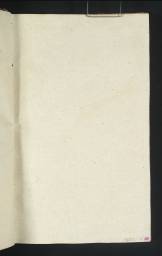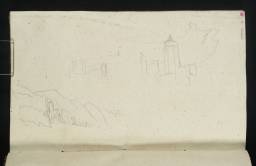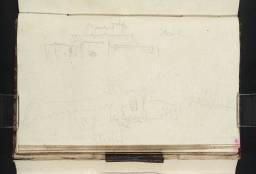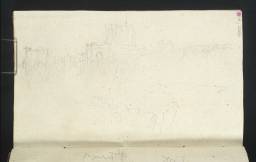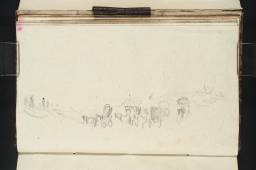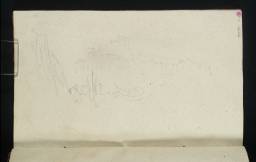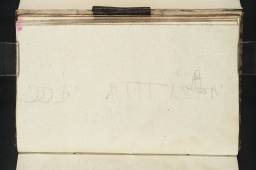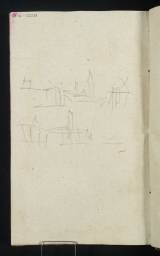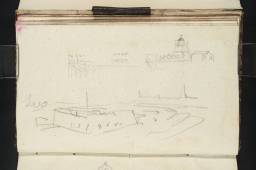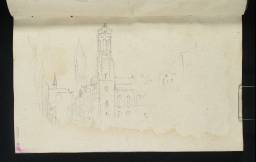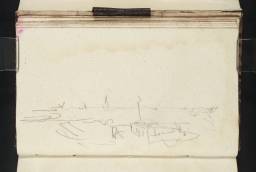Turner Bequest CCCIII 1–89
Sketchbook bound in boards, covered in paper marbled in browns; flap extending from fore-edge of front cover, folding round page block and much of back cover, where its tongue slots into corresponding integral loop; black cloth pencil loop mounted inside front cover at hinge of flap; bellows-type pocket under front paste-down (D41128)
90 leaves and paste-downs of flecked pale blue laid paper, all edges mottled in red; page size 170 x 104 mm
Possibly made by Roedter or Gossler families at Neustadt an der Weinstrasse, Rhineland-Palatinate (Rheinland-Pfalz); various leaves watermarked partially with Tree of Liberty and countermarked with indecipherable maker’s name
Numbered 314 as part of the Turner Schedule in 1854 and endorsed by the Executors of the Turner Bequest inside front cover (D41128)
Blind-stamped with Turner Bequest monogram on front cover, towards top left
90 leaves and paste-downs of flecked pale blue laid paper, all edges mottled in red; page size 170 x 104 mm
Possibly made by Roedter or Gossler families at Neustadt an der Weinstrasse, Rhineland-Palatinate (Rheinland-Pfalz); various leaves watermarked partially with Tree of Liberty and countermarked with indecipherable maker’s name
Numbered 314 as part of the Turner Schedule in 1854 and endorsed by the Executors of the Turner Bequest inside front cover (D41128)
Blind-stamped with Turner Bequest monogram on front cover, towards top left
Accepted by the nation as part of the Turner Bequest 1856
Exhibition history
References
This sketchbook, used over the course of a few days over late September and likely early October 1840, covers the last leg of Turner’s long homeward journey since leaving Venice on 3 September. Its modern title neatly encapsulates the largely straightforward three-stage aspect of its contents, as recognised by Finberg, albeit his 1909 Inventory listed its contents back-to-front,1 calling it the ‘Ostend, Rhine and Würzburg Sketch Book’, dated speculatively to about 1837–402 along with several other Continental books. At some stage he made a note to himself that it rightly belonged ‘Prbly after Coburg | return Sept 1840’.3 Turner also seems to have used it briefly once he returned to England.
Finberg recorded John Ruskin’s customary brief endorsement on a separate wrapper (since lost): ‘314. Augsburg. Some fine things; not worth dividing.’4 It is unclear which drawing(s) Ruskin identified as showing the Bavarian city, which Turner bypassed in 1840; he had however drawn its streets and onion-domed spires in his 1833 Heidelberg up to Salzburg and Venice up to Trento sketchbooks (Tate D29930, D31725; CCXCVIII 59, CCCXII 65a). In his 1994 checklist of ‘Turner’s Sketchbooks with Dutch Place Names’, the Dutch scholar Fred Bachrach dated the present book to 1839 without further comment, placing it in the same year as Brussels up to Mannheim – Rhine (Tate; Turner Bequest CCXCVI; since redated to 1833).5 Other scholars have related it to German material of 18356 or 18397 (see also the end of this Introduction), but its place at the conclusion of the 1840 itinerary and thus its current title were subsequently confirmed by Cecilia Powell.8
Since Venice, Turner’s itinerary had encompassed Trieste, Vienna, the River Danube, Passau, Regensburg, Bamberg and Coburg, where his own notes place him on Sunday 20 September; he had rounded off the somewhat congested Venice; Passau to Würzburg sketchbook (the last of three similar hardbacked books acquired on his outward journey)9 with a single drawing from his central Würzburg hotel, the Wittelsbacher Hof (Tate D31376; Turner Bequest CCCX 51), where his stay was recorded in the Neue Würzburger Zeitung of 23 September.10 Powell has noted that the present book may have been bought locally, as its paper was likely of ‘south German origin’11 (see the technical notes). The artist began using it with a thorough survey of the picturesque city, across the River Main from the imposing Marienberg fortress, over nearly forty continuous pages, likely working in consistently from the ‘back’ cover; see under folio 72 verso (D30596; CCCIII 71).12 What appears to be the waxing moon in one quick study (folio 73 verso; D30599; CCCIII 72a) suggests that he lingered for a few days.
Powell has concisely encapsulated the next phase, when the artist rapidly filled the second and third quarters of the book: ‘After Würzburg Turner headed for home, using the familiar route of the Rhine between Mainz [about eighty miles to the west] and Cologne. He almost certainly travelled by steamer, as on the Danube, sketching most of the well-known sights perfunctorily as he passed.’13 Turner had thoroughly explored this stretch of the Rhine in 1817, travelled all or part of it again in 1824, 1833, 1835 and 1839, and would continue to do so on his Swiss tours of the early 1840s.14 See also an independent sequence of Rhine pencil studies on both sides of sheets of grey paper, likely drawn as Turner passed upriver on the outward leg of the present tour (Tate D33899–D33914; Turner Bequest CCCXLI 194–209; of which D33903, D33904 and D33906 are blank).
After a few pages of indefinite landscape and river studies (folios 69 verso–71 recto; D30592–D30595; CCCIII 68a–70), the main sequence begins around Bingen, about twenty miles down the river west of Mainz, and runs roughly eighty miles north-westwards to Bonn. The landmarks on both banks, largely first identified by Powell,15 are listed here in the approximate order they would have been encountered, with reference to a single or key view in each case. Drawings made on other occasions are noted under individual entries:
the Rochuskapelle, near Bingen: see under folio 64 verso (D30582; CCCIII 63a); Burg Klopp: 67 verso (D30588; CCCIII 66a); Bingen: 65 recto (D30583; CCCIII 64); the Mäuseturm and Burg Ehrenfels: 64 verso (D30582; CCCIII 63a); Burg Rheinstein, Burg Reichenstein and the Klemenskapelle: 62 verso (D30578; CCCIII 61a); Burg Sooneck: 61 verso (D30576; CCCIII 60a); the Heimburg and Niederheimbach: 61 recto (D30575; CCCIII 60); Lorch and Burg Nollig: 60 verso (D30574; CCCIII 59a); Rheindiebach: 60 recto (D30573; CCCIII 59); Burg Fürstenberg: 59 recto (D30572; CCCIII 58); Burg Stahleck: 58 verso (D30571; CCCIII 57a); Bacharach: 57 recto (D30568; CCCIII 56); the Pfalz: 55 verso (D30565; CCCIII 54a); Kaub and Burg Gutenfels: 54 verso (D30563; CCCIII 53a); the Schönburg and Oberwesel: 52 recto (D30558; CCCIII 51); the Lorelei: 51 verso (D30557; CCCIII 50a); Burg Katz: 50 verso (D30555; CCCIII 49a); Sankt Goar: 49 verso (D30553; CCCIII 48a); Burg Rheinfels: 49 recto (D30552; CCCIII 48); Burg Maus: 47 recto (D30548; CCCIII 46); Wellmich: 48 recto (D30550; CCCIII 47); Hirzenach: 46 verso (D30547; CCCIII 45a); Burg Sterrenberg and Burg Liebenstein (the ‘Hostile Brothers’), and Bornhofen: 43 verso (D30541; CCCIII 42a); Boppard: 43 recto (D30540; CCCIII 42); the Marksburg and Braubach: 42 verso (D30538; CCCIII 41); Rhens: 41 verso (D30537; CCCIII 40a); Kapellen: 40 verso (D30535; CCCIII 39a); Schloss Stolzenfels, opposite Oberlahnstein (now part of Lahnstein), Burg Lahneck and the mouth of the River Lahn: 39 recto (D30532; CCCIII 38); Niederlahnstein (now also part of Lahnstein): 39 verso (D30533; CCCIII 38a); Ehrenbreitstein, opposite Coblenz: 39 recto (D30532; CCCIII 38)
Weissenthurm: folio 38 verso (D30531; CCCIII 37a); Neuwied: 36 verso (D30527; CCCIII 35a); Andernach: 35 recto (D30524; CCCIII 34); Hammerstein: 33 recto (D30520; CCCIII 32); Linz: 32 recto (D30518; CCCIII 31); the Erpeler Lei and Erpel: folios 29 recto, 31 recto and verso (D30512, D30516–D30517; CCCIII 28, 30, 30a); Remagen and the Apollinaris Chapel: see under 29 recto (D30512; CCCIII 28); Unkel: 28 recto and verso: D30510–D30511; CCCIII 27, 27a); Rolandseck and the Drachenfels: see under 23 recto (D30500; CCCIII 22); Nonnenwerth: see under 25 verso (D30505; CCCIII 24a); the Godesburg, near Bonn: 22 verso (D30499; CCCIII 21a); Cologne: 21 verso (D30497; CCCIII 20a)
See also an unidentified view of Rhine castles on folio 12 recto (D30479; CCCIII 11); the river may also be shown inside the front cover (D41128). There is little to indicate Turner’s route of approaching 200 miles from Cologne westwards to the coast through Belgium,16 except for two quick urban studies on folio 3 recto and verso (D30454–D30465) featuring the soaring cathedral tower at Mechelen (Malines), north of Brussels and south of Antwerp. The relevant John Murray guidebook of 1840 noted that the ‘Railroad now takes the place of all other channels of conveyance’ via a network across Belgium to and from Ostend,17 Mechelen being ‘the point of concentration at which all these lines meet.’18 The Cologne to Liège line was only ‘begun’ by then,19 but Turner could have boarded a train at Liège after travelling by road through Aachen (Aix-la-Chapelle).
At any event, the remaining quarter of the book is largely taken up with mostly rather slight views at Ostend itself, its piers and lighthouse (familiar from previous tours) and the adjacent, unspectacular coast, likely beginning with folio 22 recto (D30498; CCCIII 21); see under folio 1 recto (D30460), where various subsequent watercolours and an 1844 oil painting are discussed.20
Murray’s 1840 guide noted two return London-Ostend steamers per week, but also four return services by ‘Post-office steam-packets’ to Dover which, at eight hours, took about half the time at sea.21 That option seems likeliest given several somewhat indistinct sketches in a gap in the Ostend sequence, suggested here as views of Dover Castle from the sea, horses and carriages on the beach there, the castle from inland, and the coastal castle at Deal, to the north-east (folios 12 verso–14 recto; D30480–D30483; CCCIII 11a–13, with the subjects again in reverse of the numbered sequence). This suggests that Turner was initially heading for brief respite at his customary seaside base, Margate, at the north-eastern tip of Kent (see the Introduction to this catalogue’s ‘Margate, London and Surrey c.1829–45’ section). From there, he could have taken a steamer up the Thames and home to London, where he was attending to correspondence on Wednesday 7 October; he ‘should have answered ... sooner, but [had] only arrived from Venice a few hours’.22
Undated MS note by Finberg (died 1939) in interleaved copy of Finberg 1909, Prints and Drawings Room, Tate Britain, II, opposite p.978.
See Cecilia Powell, ‘Rhine’ in Evelyn Joll, Martin Butlin and Luke Herrmann (eds.), The Oxford Companion to J.M.W. Turner, Oxford 2001, pp.261–2.
Technical notes
How to cite
Matthew Imms, ‘Würzburg, Rhine and Ostend Sketchbook 1840’, sketchbook, September 2018, in David Blayney Brown (ed.), J.M.W. Turner: Sketchbooks, Drawings and Watercolours, Tate Research Publication, December 2019, https://www


